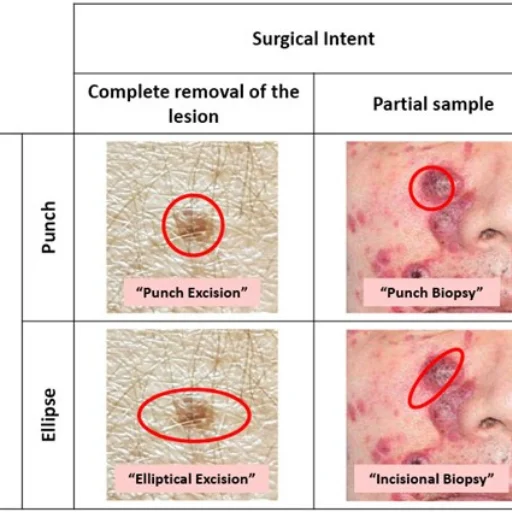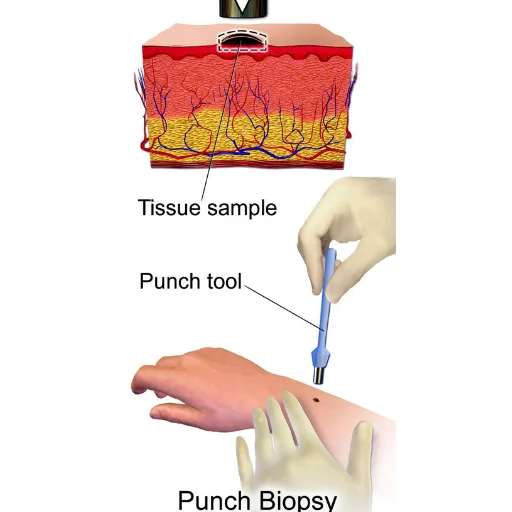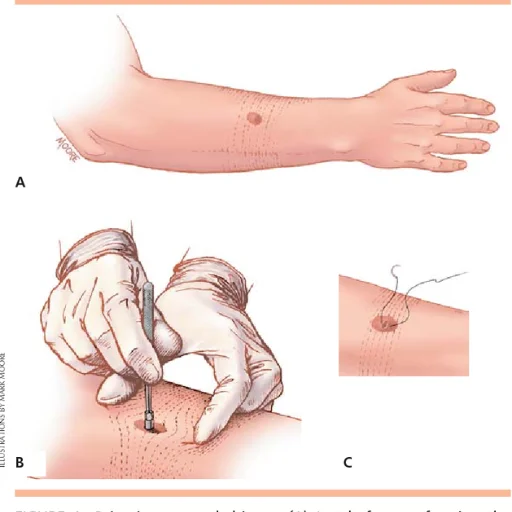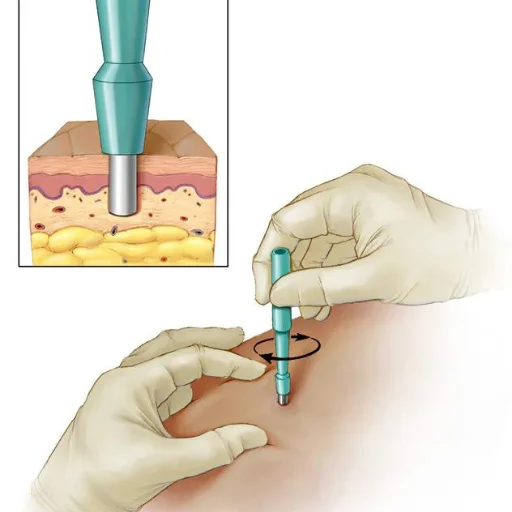Blog
Punch Skin Biopsy: Quick and Precise Diagnosis for Skin Concerns

A punch biopsy is a minimally invasive procedure used to diagnose skin conditions by removing a small, circular sample of tissue. It’s often used for suspicious moles, rashes, or other unusual skin lesions.
conditions by removing a small, circular sample of tissue. It’s often used for suspicious moles, rashes, or other unusual skin lesions.
Here’s a general overview of the process:
Before the procedure:
- Your doctor will discuss the biopsy with you and answer any questions you may have.
- You may be given local anesthesia to numb the area.
During the procedure:
- Your doctor will use a special instrument called a punch to remove a small, round piece of skin. The punch is usually about 2-4 millimeters in diameter.
- The bleeding is usually minimal and can be controlled with pressure or a styptic pencil.
- The wound may be closed with a stitch or two, or it may be left to heal on its own.
After the procedure:
- You may have some mild discomfort or bruising at the biopsy site.
- Keep the area clean and dry and avoid picking at the scab.
- Your doctor will call you with the results of the biopsy within a few days to a week.
Here are some additional things to keep in mind:
- Punch biopsies are usually very safe and have few complications.
- The scar from a punch biopsy is usually small and fades over time.
- If you have any concerns about a skin lesion, it’s important to see a doctor to get a diagnosis.

Risk and Complications of punch skin biopsy:
While punch biopsies are generally safe and well-tolerated procedures, there are some potential risks and complications to be aware of:
Minor risks:
- Bleeding: Mild bleeding is common after a punch biopsy, especially if the biopsy site is located on a blood vessel-rich area. This usually stops on its own with gentle pressure.
- Bruising: Some bruising around the biopsy site is also common and should fade within a few days.
- Pain: You may experience some discomfort or pain at the biopsy site, which can be managed with over-the-counter pain relievers.
- Scarring: Punch biopsies typically leave small, round scars that fade over time. In some cases, the scar may be more noticeable depending on the location and depth of the biopsy.
Less common risks:
- Infection: Although rare, skin infections can occur at the biopsy site. Keep the area clean and dry, and watch for signs of infection such as redness, swelling, pus, or fever. Contact your doctor if you notice any of these symptoms.
- Allergic reaction: Some people may be allergic to the local anesthetic used during the procedure. If you experience any signs of an allergic reaction, such as hives, difficulty breathing, or swelling, seek immediate medical attention.
- Nerve damage: In rare cases, the punch biopsy instrument may damage a small nerve near the biopsy site. This can cause numbness or tingling in the area. Most nerve damage is temporary and resolves on its own over time.
Factors that may increase the risk of complications:
- Certain medical conditions: If you have a bleeding disorder, diabetes, or a weakened immune system, you may be at a higher risk of complications from a punch biopsy.
- Location of the biopsy: Biopsies performed on areas with thin skin or a lot of movement, such as the face or hands, may be more likely to scar.
- Smoking: Smoking can slow down healing and increase the risk of infection.
Tips for minimizing risks:
- Discuss your medical history and any concerns you have with your doctor before the procedure.
- Follow your doctor’s instructions for caring for the biopsy site after the procedure.
- Keep the area clean and dry.
- Avoid picking at the scab.
- Watch for signs of infection and contact your doctor if you notice any.
Remember, the overall risk of complications from a punch biopsy is low. If you have any questions or concerns, be sure to talk to your doctor.
It’s important to note that these are just general risks and complications. The specific risks for you will depend on your individual health and the location of the biopsy. Be sure to talk to your doctor about your specific concerns.
Punch Skin Biopsy: A Closer Look at Skin Lesions

A punch skin biopsy is a minimally invasive procedure used to diagnose a wide range of skin conditions. It involves removing a small, circular sample of tissue using a special tool called a punch. This sample is then examined under a microscope by a pathologist to determine the underlying cause of the skin lesion.
When is a punch biopsy used?
Doctors may recommend a punch biopsy for various reasons, including:
- Suspicious moles: If a mole has changed in appearance, size, or color, a biopsy can help rule out skin cancer.
- Rashes: Persistent rashes that don’t respond to treatment or have unusual features may require a biopsy for diagnosis.
- Blisters: Blisters caused by autoimmune diseases or infections may need to be biopsied for proper diagnosis.
- Lumps or bumps: Unexplained lumps or bumps under the skin can be biopsied to determine their nature.
What to expect during a punch biopsy:

The procedure is usually performed in a doctor’s office or clinic. Here’s a general overview of what to expect:
- Preparation: The area around the lesion will be cleaned and numbed with a local anesthetic.
- Punching: The doctor uses a punch tool to remove a small, cylindrical sample of tissue. The size of the punch depends on the size and depth of the lesion.
- Bleeding control: Minor bleeding is common and is usually controlled with pressure or a styptic pencil.
- Stitching: In some cases, the doctor may close the wound with one or two stitches.
- Recovery: The biopsy site may be sore or tender for a few days. Keep the area clean and dry and avoid picking at the scab.
Benefits of a punch biopsy:
- Accuracy: Punch biopsies provide a highly accurate way to diagnose skin conditions.
- Minimally invasive: The procedure is relatively quick and painless, with minimal scarring.
- Cost-effective: Punch biopsies are generally less expensive than other diagnostic tests, such as excisional biopsies.
Risks and complications:
- Punch biopsies are generally safe procedures, but like any medical intervention, there are some potential risks, such as:
- Infection: Although rare, skin infections can occur at the biopsy site.
- Bleeding: Excessive bleeding is uncommon but can occur in some cases.
- Scarring: While most scars fade over time, some may be more noticeable depending on the location and depth of the biopsy.
Overall, punch skin biopsies are a valuable tool for diagnosing a variety of skin conditions. If you have any concerns about a skin lesion, be sure to consult your doctor to see if a biopsy is right for you.
Punch Biopsy: Tracking Skin Disease

Punch skin biopsies can play a crucial role in monitoring the progression of certain skin diseases, providing valuable insights for informed treatment decisions. While not every skin condition requires regular biopsies, certain situations benefit from this minimally invasive procedure:
Tracking Activity:
- Autoimmune Conditions: For diseases like psoriasis or bullous pemphigoid, monitoring inflammatory activity through serial biopsies can help adjust immunosuppressant medications or guide other treatment adjustments.
- Tumor Surveillance: In cases of certain basal cell carcinomas or other slowly growing tumors, periodic biopsies can ensure complete removal and track any potential recurrence.
Evaluating Treatment Response:
- Dermatologic Treatment Efficacy: For conditions like atopic dermatitis or severe acne, biopsies can assess the effectiveness of topical or systemic treatments by revealing changes in skin structure and inflammation.
- Transplant Rejection Monitoring: In skin graft or bone marrow transplant recipients, regular biopsies help detect early signs of rejection, crucial for prompt intervention and preventing graft loss.
Identifying Disease Progression:
- Gradual Changes: For slowly evolving conditions like lichen planus or morphea, serial biopsies can capture subtle changes in tissue structure, potentially indicating disease progression or response to treatment.
- Differential Diagnosis: In cases with overlapping clinical features, serial biopsies can provide valuable clues for accurate diagnosis, especially when initial biopsies were inconclusive.
Remember:
- Consult your doctor: The decision to use punch biopsies for monitoring should be made by your dermatologist or healthcare provider based on your specific condition and treatment plan.
- Individualized approach: The frequency and timing of biopsies will vary depending on the disease, its activity, and individual response to treatment.
- Minimally invasive: While not entirely risk-free, punch biopsies are generally safe and well-tolerated, offering valuable insights with minimal impact.
By providing valuable information about disease activity, response to treatment, and potential progression, punch skin biopsies can be a powerful tool in managing various skin conditions, ultimately contributing to optimal treatment outcomes and improved patient well-being.
Additional Notes:
- It’s important to prioritize patient comfort and minimize anxiety throughout the process.
- Clear communication and informed consent are essential before any biopsy procedure.
- Respecting patient privacy and adhering to ethical guidelines is paramount.
Final Thoughts:
Punch skin biopsies strike a fine balance between minimally invasive procedures and insightful diagnoses. Offering a quick peek into the world beneath the skin, they help diagnose a vast array of conditions, monitor disease progression, and guide treatment decisions with remarkable accuracy. While not without potential risks, their benefits often outweigh concerns, making them a valuable tool in safeguarding skin health and well-being.
Derma and Dental Clinic:
Derma & Dental Clinic stands out with its team of experienced doctors backed by scientific evidence in their chosen fields. Their diverse range of medical-grade procedures offer tailored solutions for various skin and dental needs. You can confidently book your consultation online or by phone and embark on your journey towards healthier skin and a radiant smile.
Location: Bahria Town, Lahore
Specialties: Dermatology and Dental Care
Website: Derma.pk
For Consultation:
- Online at Dermatology.pk
- WhatsApp: +923205999650
- Phone: 03041115000
Prof Dr.Tariq Rashid
Categories
- Accessoreis
- Acne
- Aesthetic Procedures
- Anti Aging
- Author
- Baby Care
- Beauty
- Beauty & Cosmetics
- Blog
- Body Care
- cosmetic procedures
- Dandruff
- Dental Bonding
- Dental Care
- Dental Fillings
- Dental Health
- Dermatologist
- Dermatology
- Doctor
- Downloads
- Eye Care
- Food
- Food and Nutrition
- Hair Care
- Hair Loss Treatment
- Haircare
- Hand and foot care
- Health
- Health and Wellness
- Healthcare
- Imported Products
- Kids and baby care
- Laser Hair Removal
- Lip Care
- Medication
- Men's skin care
- Men's Skincare
- Nail Care
- Nutrition
- Oily Skin
- Online Consultation
- Oral Health
- Personal Care
- Pharmaceuticals
- Procedures
- Products and Ingredients
- scalp care
- Science
- Self care and wellness
- Shampoo
- Skin and Scalp Conditions
- Skin Care
- Skin Care and lifestyle
- Skin care myths and facts
- Skin Treatment
- Skincare
- skincare products
- Smile Design
- sunblocks
- Teeth Whitening
- wellness
- Whitening and brightening














